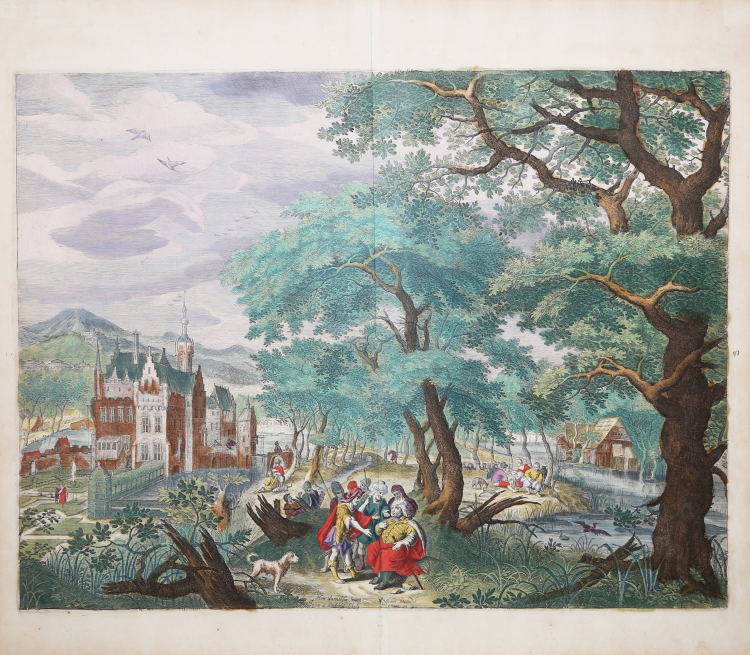



| Reference: | S7106 |
| Author | Jan van LONDERSEEL |
| Year: | 1614 ca. |
| Measures: | 483 x 355 mm |


| Reference: | S7106 |
| Author | Jan van LONDERSEEL |
| Year: | 1614 ca. |
| Measures: | 483 x 355 mm |
Engraving, 1614 circa, lettered within image, in lower centre: Hen. daenelsen Inuen. / Joan. a londersel schulp. and CIVisscher excudit / 1 Samu 25.4. After Hendrik Danielsz.
The scene appears to show - according 1 Samuel 25.4- David (who was not yet king) seated in central foreground consulting his companions, a dog at left, a castle surrounded by a moat and a garden in left background, pastoral scenes in right background, with the shearing of sheep.
This biblical narrative, recounted in 1 Samuel 25:2–42, describes an episode during David's exile in the wilderness in southern Judah. David, in need of provisions, sent some of his men to request aid from a wealthy sheep farmer named Nabal, whose herd David had let graze unmolested all winter. The sheep farmer curtly refused their request. Infuriated, David set out with 400 armed men to seek revenge. Nabal's wife, Abigail, having learned of David's impending attack, quickly packed generous provisions—including bread, wine, meat, and fruit—on the backs of donkeys, and set out to intercept David and his soldiers. She pleaded with David to forego his punitive action, reminding him that he was fighting the Lord's battles and should not allow evil into his life. Abigail returned home and her joyous news caused her husband's heart to die "within him, and he became as a stone." Upon hearing of Nabal's death, David assumed that God had acted to support his cause and rejoiced, after which he promptly sent servants to ask Abigail to marry him. She consented and became David's second wife.
Magnificent proof, splendid contemporary hand-colouring, printed on contemporary laid paper, watermark "coat of arms with fleur-de-lis", with margins, usual trace of central vertical fold, in very good condition.
The excellent quality of the colouring significantly distinguishes and enhances these examples from those in black and white.
|
Hollstein 112
|
Jan van LONDERSEEL (Anversa circa 1570 – Rotterdam 1624/25)
|
Flemish engraver, etcher and print publisher. He apparently trained in Antwerp, where he may have worked in the workshop of Abraham de Bruyn, father of his brother-in-law Nicolaes de Bruyn. About 1600 he followed his brother A(ha)ssuerus van Londerseel (bapt Antwerp, 30 March 1572; d before 21 May 1649), also an engraver and print publisher, to Rotterdam. He seems to have been active there between 1610 and 1625; in 1614 he was living in Delft.
|
|
Hollstein 112
|
Jan van LONDERSEEL (Anversa circa 1570 – Rotterdam 1624/25)
|
Flemish engraver, etcher and print publisher. He apparently trained in Antwerp, where he may have worked in the workshop of Abraham de Bruyn, father of his brother-in-law Nicolaes de Bruyn. About 1600 he followed his brother A(ha)ssuerus van Londerseel (bapt Antwerp, 30 March 1572; d before 21 May 1649), also an engraver and print publisher, to Rotterdam. He seems to have been active there between 1610 and 1625; in 1614 he was living in Delft.
|